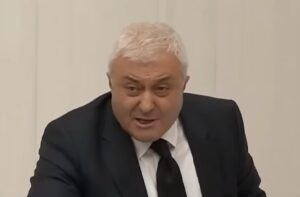Abdullah Bozkurt/Stockholm
Turkish intelligence agency MIT has been using journalism as a cover to infiltrate and collect intelligence in other countries, dispatching its agents and assets as reporters to engage in spying, several sources familiar with the modus operandi of MIT told Nordic Monitor.
“Mostly it was reporters who worked for state news agency Anadolu and Turkish Radio and Television [Türkiye Radyo ve Televizyon Kurumu, TRT] who were tapped as assets by MIT,” said one source who had served in a senior position in Turkish military intelligence. The source, who spoke anonymously for fear of repercussions from the Turkish government, said these reporters regularly filed reports and coordinated their work with their handlers.
Yahya Bostan, the news coordinator for Anadolu, is one of those who work for Turkish intelligence. He had previously worked as news coordinator for TRT News for four years between 2017 and 2021. Before moving to the state-funded media, he was employed by the Sabah newspaper, owned by the Turkish president’s family. Bostan often writes articles praising MIT in his weekly column for the Islamist Yeni Şafak daily.
Bostan was red flagged during a 2011-2014 terrorism probe into Iran’s Quds Force network in Turkey and listed as a suspect by prosecutors. He was put under surveillance and his phones were tapped by prosecutors who secured court warrants to determine Bostan’s clandestine connections. The investigation revealed he was regularly in contact with several high-profile Quds Force operatives. Prosecutors also discovered he was coordinating his activities with Nuh Yılmaz, a senior MIT official known for his anti-Israel and pro-mullah regime views who had worked for an Iranian-funded Turkish publication in the 1990s. The Quds Force probe was killed by the government of then-prime minister and current president Recep Tayyip Erdogan in February 2014 after it exposed a number of senior officials’ links to Quds Force cells.
Judge’s warrant authorizing the wiretapping of Yahya Bostan’s phone in the IRGC Quds Force probe:
“Assets in the opposition media are quite valuable in helping the intelligence agency run its influence campaign to shape the national debate around certain issues effectively,” said another source who asked that his name to be withheld for security reasons. The perceived opposition journalists run fewer risks for triggering red flags during clandestine work, the source underlined.
Documentary evidence and leaks in recent years revealed by Nordic Monitor have confirmed what the sources described, presenting a distinguishable pattern of this modus operandi.
Using journalism as a cover in overseas operations to gather intelligence is perhaps more valuable for the agency than using it for domestic operations in Turkey, where it has more resources and assets in friendly territory. Journalists’ access to foreign government institutions and officials as well as people and entities in the nongovernmental corporate and nonprofit sectors provides a valuable avenue for gathering intelligence for MIT.
Secret document filed by Turkish prosecutor Adem Özcan asking the the court to authorize a wiretap for Quds Force suspect Yahya Bostan:
In many cases, press credentials were used to mask clandestine operations that would otherwise run the risk of exposure and trigger closer scrutiny by host countries’ intelligence services. In some cases journalists who want to register in host countries or with international organizations are required to provide credentials from Turkish embassy press sections, which come in handy for managing and coordinating MIT’s operations.
In one recent case, a MIT agent was caught in Ukraine in 2019 when he was posing as a journalist to monitor the extradition proceedings of Nuri Gökhan Bozkır, an ex-military officer and arms smuggler who provided arms to jihadists in Syria on behalf of the Erdogan government. During a hearing at an Ankara court on February 12, 2023 , Bozkır related how an intelligence officer showed up to a hearing in Kiev in 2019. When court officials questioned the agent’s credentials, he claimed to be a Turkish journalist but was later found to be an intelligence officer and was escorted from the courtroom.

In some cases, MIT also positions its agents as press attachés at Turkish embassies, with the foreign ministry providing them with diplomatic credentials. Swiss prosecutors exposed one such situation in 2018 when they issued an arrest warrant for Hacı Mehmet Gani, who worked as press attaché at the Turkish embassy in Bern. Gani and Hakan Kamil Yerge, second secretary at the embassy, were accused of orchestrating a plot to kidnap a businessman who was a critic of the Turkish president. The supposed diplomats fled Switzerland before the arrest warrants were served.
On the home front, MIT has aggressively been pursuing a public information campaign to impact the domestic agenda and create a narrative that would best serve the Islamist government of President Erdogan as well as its militant, neo-nationalist allies. During the two decades of Erdogan’s rule, MIT has taken this operation using journalism as a cover to a new level by overhauling what used to be a low-key press section and turning it into part of a psychological and influence operation (PSYOP) department, recruiting many reporters, photographers and social media influencers.
There is no single program at the agency that coordinates all the agents, assets and informants in media outlets. Instead, multiple departments at MIT have their own group of journalists to handle. Due to compartmentalization and separation on a strictly need-to-know basis at the agency, handlers of journalists for one department may not know which journalists work for another department. The entire picture of who’s who and who works for which department that uses undercover agents in the media is only for the eyes of the MIT chief, Hakan Fidan, an Erdogan confidant.

Only a fraction of MIT agents and assets have been exposed in recent years, and their identities were revealed thanks to court documents, leaks and whistleblowers. It represents only the tip of the iceberg and does not truly reveal the extent and depth of MIT operations in the journalism field.
Perhaps the most notorious case is that of Hayri Birler, who had worked for the Hürriyet. Milliyet and Turkish Daily News (later renamed the Hürriyet Daily News) dailies in Ankara in the 1980s and 1990s. He had been a MIT agent and worked undercover as a journalist for years before he was ordered to leave the media and serve as regional director for the agency in Turkey’s Diyarbakır province. He is now retired.
Nuh Yılmaz is another MIT agent who had worked in the US and Turkey as a journalist before he was appointed head of the agency’s press department in 2013. Yılmaz, a protégé of Fidan, was later promoted to the counterespionage department and plays an instrumental role in influence operations on behalf of the agency.
Yılmaz runs a number of agents, assets and informants in traditional Turkish media outlets as well as online news websites, some of which are obscure and serve to muddy the waters by floating conspiracy theories. The leaked emails of President Erdogan’s son-in-law Berat Albayrak revealed in 2016 that MIT was feeding information to his agents planted in the Sabah daily, owned by Erdogan’s family. Emails from 2012 showed that Abdurrahman Şimşek, Ferhat Ünlü and Nazif Karaman were in the loop and receiving information from the agency.

At the direction of the agency, this trio wrote a book in December 2018 on the murder of Saudi journalist Jamal Khashoggi, who was assassinated by Saudi government operatives at the Saudi Consulate General in Istanbul on October 2, 2018. The information surrounding the murder was provided by MIT, which had bugged the consulate before sending Khashoggi and his Turkish fiancée there as part of the Erdogan government’s move to gain leverage over Saudi Arabia.
Ünlü wrote several books promoting MIT and how the agency has successfully completed espionage operations under Fidan. For several years now, Şimşek has been working with a team of MIT agents in hunting down investigative journalists who fled Turkey to escape wrongful imprisonment by the Erdogan regime. The secret photos, home addresses and daily routines of journalists in the US and Europe, apparently obtained as part of long-running surveillance programs, were published in the Sabah daily by Şimşek and his colleagues in the spy agency.
Another exposure of a MIT agent was made in 2011, when prosecutors investigated a series of terrorist attacks in Istanbul. The police detained dozens of people who were connected to the attacks. One of the detainees was a Turkish photojournalist named Mustafa Özer, who had long been working for Agence France-Presse (AFP). During police questioning Özer revealed his MIT identity and detailed the clandestine infiltration and intelligence-gathering operations he and MIT agents were involved in. He even revealed how MIT directed him to set up a fake news website to make the operations appear to be legitimate journalistic activity.

Hande Fırat, the Hürriyet daily’s Ankara bureau chief and anchor of a debate program on CNN Türk, is a MIT operative whose frequent visits to MIT headquarters were exposed in court records and reported on by Nordic Monitor. Her role in a 2016 coup attempt with a staged interview of Erdogan on FaceTime was revealed to be part of a false flag operation planned by the intelligence agency.
Fatih Altaylı, a TV host and editor-in-chief of the HaberTürk daily, has been revealed to be on MIT’s payroll for a long time. The revelation was made by Mehmet Eymür, a retired MIT official who served in senior positions in the agency’s special bureau and counterterrorism and operations departments for many years. According to him, Altaylı was recruited for his links to leftist groups and was regularly invited to MIT headquarters for debriefings and to receive new instructions.
“Altaylı was the number one agent of the MIT Istanbul Regional Directorate when I worked for the agency. He approached the agency [for recruitment] by revealing that he had special relations with some terrorist organizations,” Eymür said. The journalist was using the code name Siyah (Black), according to the intelligence agency’s records.

Tuncay Özkan, a former journalist who is now a lawmaker from the opposition Republican People’s Party (CHP), is another MIT agent who had for a long time used journalism as a cover. Thanks to his special ties to the agency, Özkan had quickly gone from being a reporter involved in clandestine operations in the 2000s, even running afoul of the criminal justice system, to being the owner of a TV network. Özkan is believed to be one of the Trojan horses in the opposition bloc who maintains close ties with his handler, Şenkal Atasagun, a former head of the intel agency and currently chief advisor to far-right leader Devlet Bahçeli.
A book he wrote titled “Mit’in Gizli Tarihi” (The Secret History of MIT), which was published in 2010, was a special project contracted by MIT to promote the agency.
Mehmet Faraç, who had worked for the leftist, nationalist Cumhuriyet daily until 2010, is reportedly another journalist who works for the intel agency. His links to the agency were revealed during the Ergenekon trials between 2009 and 2012 and were confirmed in November 2021 by Akın Atalay, the former chairman of the board at Cumhuriyet. He currently works for the far-right Yeniçağ news outlet.
The revelations made by two senior MIT officials, Erhan Pekçetin and Aydın Günel, who were captured by the outlawed Kurdistan Workers’ Party (PKK) in Iraq’s Kurdish city of Sulaymaniyah on August 4, 2017, also provided insight into journalists who work for the agency. Pekçetin was head of the department responsible for ethnic and separatist groups operating outside of Turkey’s borders, while Günel used to manage the human resources department at MIT, responsible for developing human intelligence in the field and bringing in new recruits and informants.
The two said MIT expanded its operations in media outlets after Fidan became the country’s top spy and transferred Yılmaz to the agency, which irritated career intelligence officials. Yılmaz had no intelligence background and had been red flagged for having worked for a radical, Iranian-funded publication in the 1990s as well as for his ties to the Foundation for Human Rights and Freedoms and Humanitarian Relief (İnsan Hak ve Hürriyetleri ve İnsani Yardım Vakfı, or IHH), a jihadist charity organization with links to al-Qaeda and the Islamic State in Iraq and Syria (ISIS).

Nevertheless, with support from Fidan and the government, Yılmaz was put in charge of running assets in Turkish media outlets. MIT officials also confirmed Fırat’s frequent visits to intelligence headquarters for briefings and debriefings.
According to MIT officials who had been exposed, Çetiner Çetin, a journalist working for Habertürk, and Cem Küçük, who works for the Türkiye newspaper and often appears as a commentator on Turkish TV, are also connected to the intelligence agency.
Unfortunately, there is no oversight of the intelligence agency by the Turkish parliament, and a committee established to oversee of the agency was rendered ineffective and has rarely convened in recent years. The opposition has also failed to raise the use of journalism as a cover for agents on various platforms, largely remaining silent about the revelations in recent years.
Turkish intelligence enjoys broad immunity under amended Turkish law thanks to the Erdogan government and acts with impunity even if it’s breaking existing laws. Erdogan protected Fidan in 2012 when prosecutors discovered that criminals who were terrorizing the streets of Istanbul were on the MIT payroll. In 2014, when MIT agents were busted near the Turkish-Syrian border while illegally trafficking arms for jihadist groups in Syria, Erdogan intervened again to kill the investigation.












